外研版(2019)选择性必修第一册Unit 5 Revealing nature Developing ideas课件(共43张PPT)
文档属性
| 名称 | 外研版(2019)选择性必修第一册Unit 5 Revealing nature Developing ideas课件(共43张PPT) |  | |
| 格式 | pptx | ||
| 文件大小 | 8.2MB | ||
| 资源类型 | 教案 | ||
| 版本资源 | 外研版(2019) | ||
| 科目 | 英语 | ||
| 更新时间 | 2024-10-11 15:25:52 | ||
图片预览

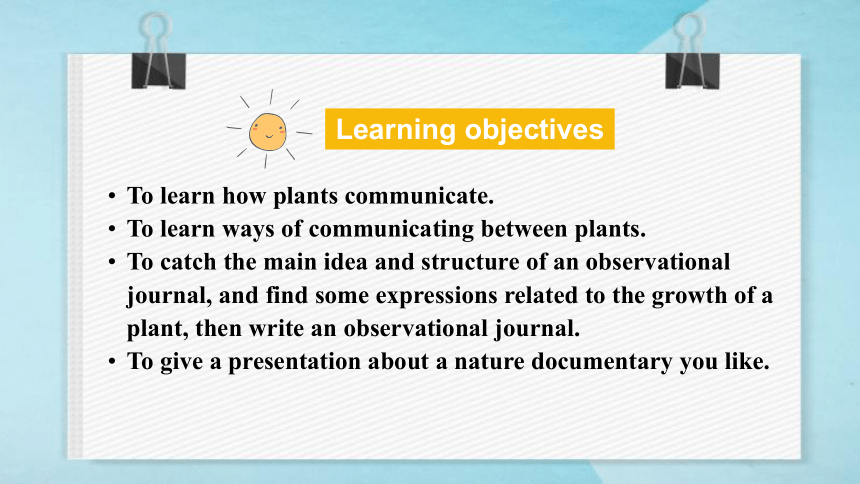
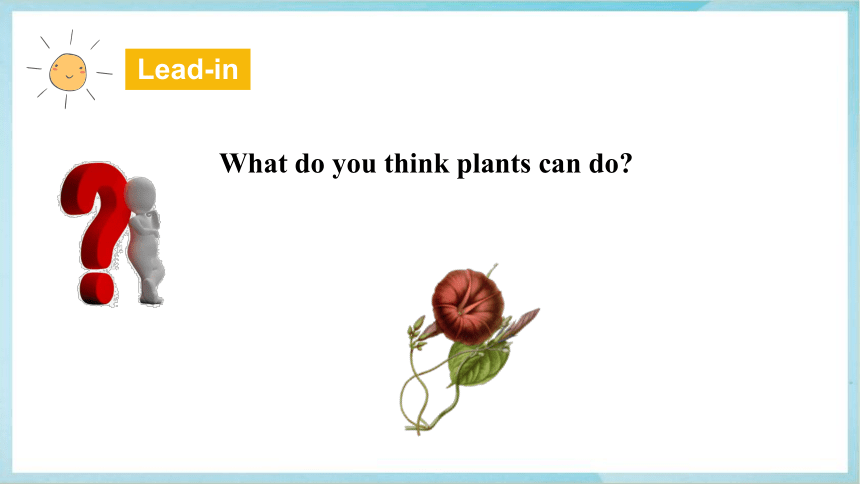
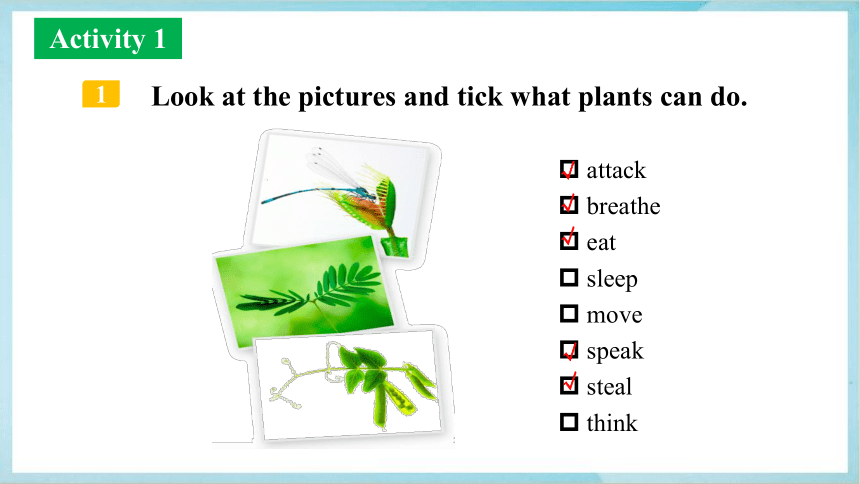
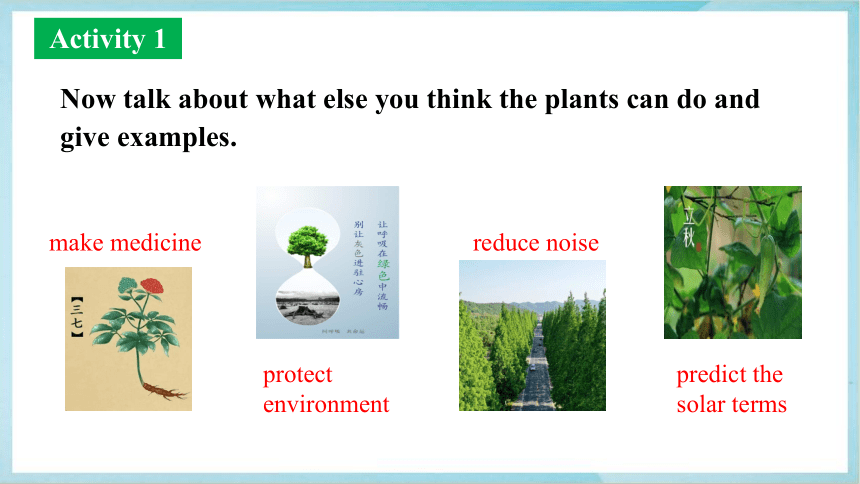
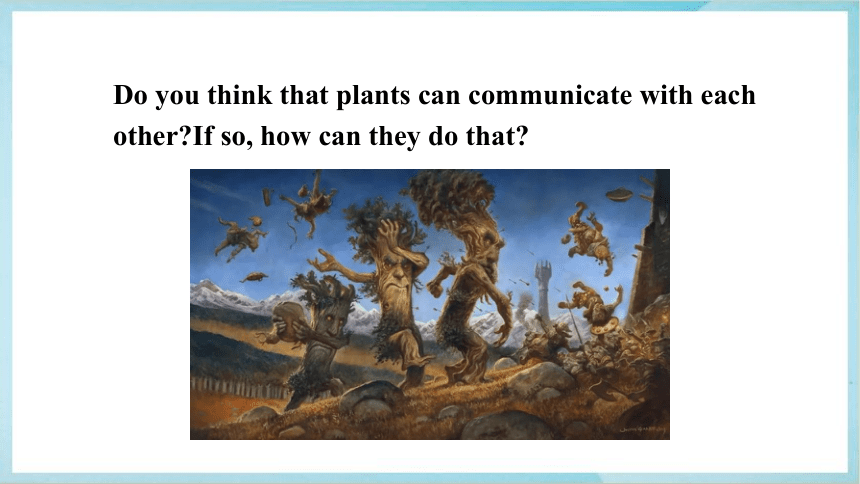
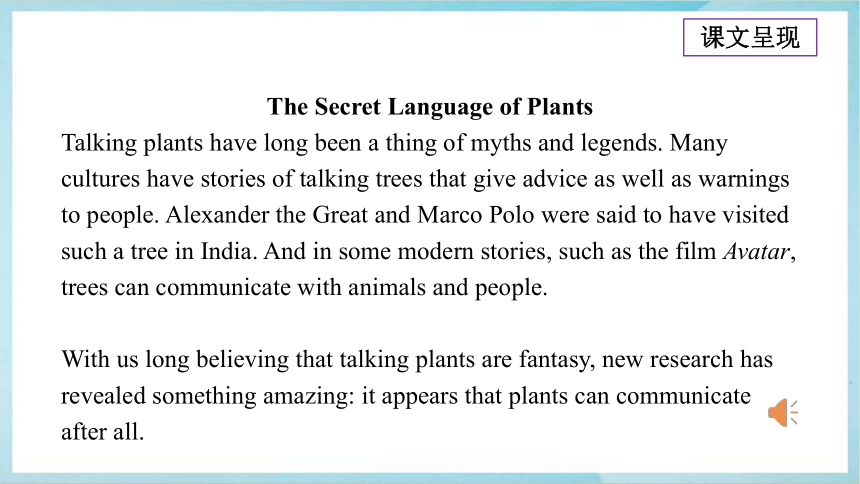
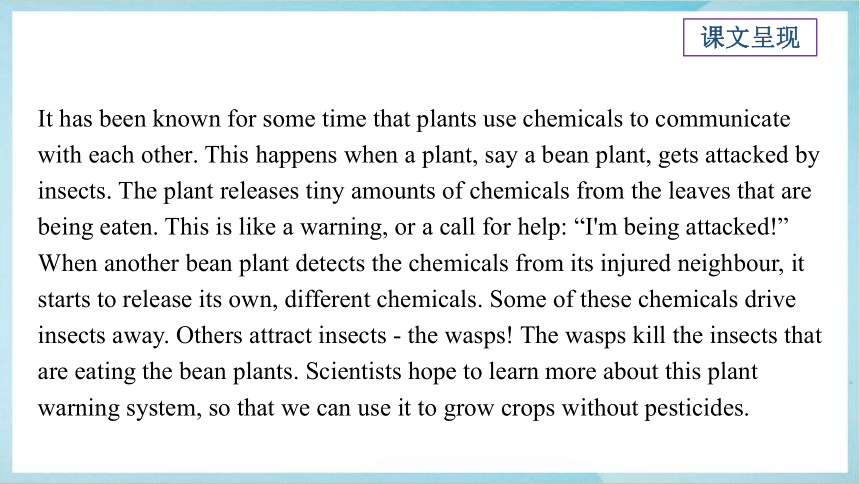
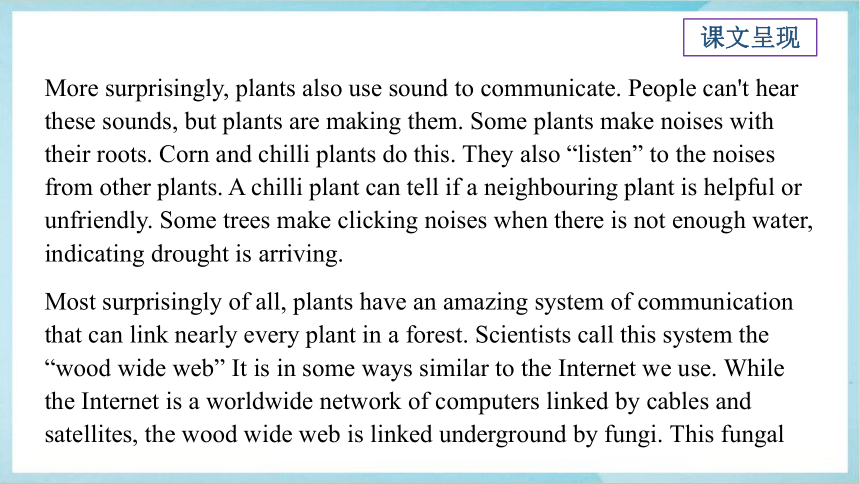

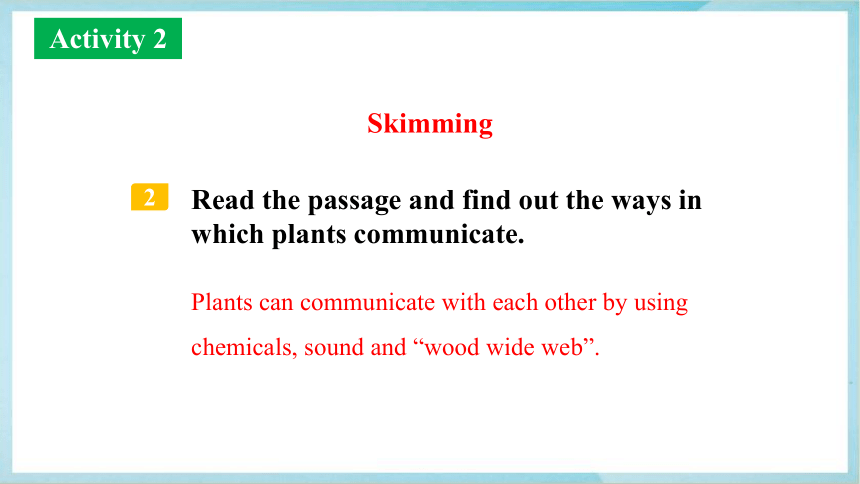
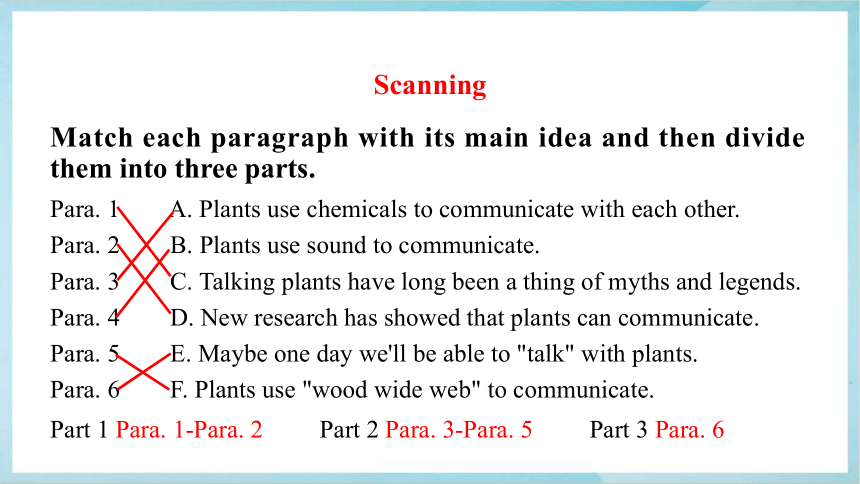
文档简介
(共43张PPT)
Unit 5 Developing ideas
The Secret Language of Plants
植物密语
阅读课件
To learn how plants communicate.
To learn ways of communicating between plants.
To catch the main idea and structure of an observational journal, and find some expressions related to the growth of a plant, then write an observational journal.
To give a presentation about a nature documentary you like.
Learning objectives
What do you think plants can do
Lead-in
1
Look at the pictures and tick what plants can do.
attack
breathe
eat
sleep
move
speak
steal
think
√
√
√
√
√
Activity 1
Now talk about what else you think the plants can do and give examples.
make medicine
protect
environment
reduce noise
predict the solar terms
Activity 1
Do you think that plants can communicate with each other If so, how can they do that
The Secret Language of Plants
Talking plants have long been a thing of myths and legends. Many cultures have stories of talking trees that give advice as well as warnings to people. Alexander the Great and Marco Polo were said to have visited such a tree in India. And in some modern stories, such as the film Avatar, trees can communicate with animals and people.
With us long believing that talking plants are fantasy, new research has revealed something amazing: it appears that plants can communicate after all.
课文呈现
It has been known for some time that plants use chemicals to communicate with each other. This happens when a plant, say a bean plant, gets attacked by insects. The plant releases tiny amounts of chemicals from the leaves that are being eaten. This is like a warning, or a call for help: “I'm being attacked!” When another bean plant detects the chemicals from its injured neighbour, it starts to release its own, different chemicals. Some of these chemicals drive insects away. Others attract insects - the wasps! The wasps kill the insects that are eating the bean plants. Scientists hope to learn more about this plant warning system, so that we can use it to grow crops without pesticides.
课文呈现
More surprisingly, plants also use sound to communicate. People can't hear these sounds, but plants are making them. Some plants make noises with their roots. Corn and chilli plants do this. They also “listen” to the noises from other plants. A chilli plant can tell if a neighbouring plant is helpful or unfriendly. Some trees make clicking noises when there is not enough water, indicating drought is arriving.
Most surprisingly of all, plants have an amazing system of communication that can link nearly every plant in a forest. Scientists call this system the “wood wide web” It is in some ways similar to the Internet we use. While the Internet is a worldwide network of computers linked by cables and satellites, the wood wide web is linked underground by fungi. This fungal
课文呈现
network links the roots of different plants to each other. Using the wood wide web, plants can share information and even food with each other. For example, some pine trees can send food to smaller pine trees to help them grow. But just like our own Internet, the wood wide web has its own version of “cybercrime”. Plants can steal food from each other, or spread poisons to attack other plants. Perhaps one day scientists will learn how to create a “firewall” to help prevent these attacks within the wood wide web.
Scientists are learning more every day about the secret ways in which plants talk to each other. Who knows Maybe one day we will know enough about plant communication to be able to “talk” with them ourselves.
课文呈现
2
Read the passage and find out the ways in which plants communicate.
Plants can communicate with each other by using chemicals, sound and “wood wide web”.
Skimming
Activity 2
Scanning
Match each paragraph with its main idea and then divide them into three parts.
Para. 1 A. Plants use chemicals to communicate with each other.
Para. 2 B. Plants use sound to communicate.
Para. 3 C. Talking plants have long been a thing of myths and legends.
Para. 4 D. New research has showed that plants can communicate.
Para. 5 E. Maybe one day we'll be able to "talk" with plants.
Para. 6 F. Plants use "wood wide web" to communicate.
Part 1 Para. 1-Para. 2 Part 2 Para. 3-Para. 5 Part 3 Para. 6
3
Organise information from the passage and complete
the diagram.
Careful reading
Activity 3
communicate with each other
from the leaves
release its own, different chemicals
with their roots
tell if a neighbouring palnt is helpful or unfriendly
clicking noise when there is not enough water, indicating drought is arriving
the roots of different plants to each other
share information and even food
steal food from each other, or spread poisons
Think Share
1 What figure of speech is being used when the plants are described as
calling for help What is its function
2 What does “wood wide web” mean
3 What do you think are the benefits of studying plant communication
4 What discoveries are described in the two reading passages in this
unit and what do their meanings have in common
1 What figure of speech is being used when the plants are described as calling
for help What is its function
2 What does “wood wide web” mean
Personification. It can make descriptions more vivid.
“Wood wide web” means an amazing system of communication that can link nearly every plant in a forest. It is linked underground by fungi and this fungal network links the roots of different plants to each other. Using the wood wide web, plants can share information and even food with each other.
Think Share
First, plants can releases chemicals to drive away the insects that are harmful to them, while also attracting beneficial insects that can kill such insects to come to their rescue. Second, plants can use their roots or leaves to make sounds to determine whether nearby plants are friends or enemies, and can also predict whether the weather is dry or rainy. Third, plants can also use the "wood wide web" to share information and even food with each other. So plants have an amazing information communication system that helps them grow healthier. Therefore, the study of plant communication is beneficial to the healthy growth of plants.
3 What do you think are the benefits of studying plant communication
首先,植物可以释放化学物质来赶走对它们有害的昆虫,同时也吸引能杀死这些昆虫的益虫来拯救它们。 其次,植物可以用它们的根或叶子发出声音来判断附近的植物是敌是友,还可以预测天气是干燥还是下雨。 第三,植物也可以利用“植物万维网”来相互分享信息甚至食物。 所以植物有一个神奇的信息交流系统,帮助它们更健康地生长。 因此,研究植物信息交流有利于植物的健康生长。
Think Share
Learning to learn
Personification means giving human characteristics to something that is not human. By using human characteristics to describe an object, animal or even a place, personification can make descriptions more vivid.
4 What discoveries are described in the two reading passages in this unit and
what do their meanings have in common
Passage 1 reveals the discovery of evolution and Passage 2 reveals the discovery of communication between plants. They all reflect that there are numerous secrets in nature that remain to be explored.
Think Share
4
Work in groups. Give a talk about communication between living things.
1 Read the passage again and talk about how plants communicate.
2 Think about and discuss the following ways of communication in
the animal world.
Bees “dance” to signal to other bees that they have found food.
Ants communicate with each other through touch, chemical signals,
moving their bodies and even using their legs to make sounds.
What other ways can you think of
3 Organise your ideas following the steps below.
Begin with what living things you have chosen to talk about.
Explain how they communicate and give examples.
Conclude by explaining what we have learnt from their behaviour.
4 Give a talk to the class about communication between living things.
Activity 4
Now talk about how well you contributed to your group discussion and help each other to make improvements.
Retelling The Secret Language of Plants
Para. 1 Talking plants have long been a thing of myths and legends.
Para. 2 New research has showed that plants can communicate.
Para. 3 Plants use chemicals to communicate with each other.
Para. 4 Plants use sound to communicate.
Para. 5 Plants use "wood wide web" to communicate.
Para. 6 Maybe one day we'll be able to "talk" with plants.
Writing an observational journal
__________________________________________
写观察日志
Look at the picture and put the words in the right place. Refer to dictionary, if necessary.
Look and identify
flower, bulb, leave, stem, root
Activity 5
Check answer with class and answer question:
Think and answer
What should be recorded when writing an observational journal
Writing an observational journal
1 How were the daffodil bulbs
planted
2 In what environment did the
leaves grow
3 What do the flowers look like
They were planted side by side in soil with the pointed ends facing up.
The leaves grew in a sunny, but cool place..
The flowers are yellow and white, and shaped like trumpets.
Read the observational journal and answer the questions.
Structure(结构) of an observational journal
time
environment
what it is like
the way to plant
environment
special requirement
color
height
shape
texture
sprout
observational journal
Writing an observational journal
Look at the pictures and talk about how the sunflower grows.
Write your observational journal about the sunflower.
Activity 6
One day I buried some seeds of sunflowers into a basin, where there was some rich soil. After pouring some water into it, I began to observe it with great patience. Several days later, some green shoots grew out of the soil, which were so lovely. Seeing that the soil was a little dry, I added some water to it again. After twenty days, those young plants grew into some tall plants, which were very strong. I was surprised at what I saw that day! How amazing it is to watch a seed become a tall plant!
Writing an observational journal
Writing an observational journal
1 June
Covered with 1-2 cm of moist soil, the sunflower seed takes a few days to come up after being planted. Water has been added regularly and the hard seed coat softens in the damp soil to allow the first root to pierce downwards and the first leaves to push to the soil surface.
6 July
The root continues to grow downwards. The single stem grows hollow and smooth, revealing large spade-shaped leaves from the growing tip. Gradually, the plant’s growing tip reveals the first hints of development of the flower bud. The plant stem becomes more woody.
Writing an observational journal
26 July
About three weeks after the flower bud first becomes visible at the tip of the sunflower stem, it enlarges and begins to reveal a flattened disc. Over the course of one week, the yellow ray florets, the disc florets bloom across the core of the sunflower blossom. It is yellow, looking beautiful.
Look at the pictures and talk about how the sunflower grows.
Write your observational journal about the sunflower.
April to June
Another possible version
段落仿写:
The sunflowers are usually planted from April to June. The seeds /seedlings have been planted in the wet soil, with the pointed ends facing up. Water has been added and the container was put in a sunny and bright place. The seeds/seedlings are being watered regularly.
段落仿写:
A single stem has sprouted from the seeds/seedlings. On the stem are some leaves, which are big and wide. The container has been put in a sunny and bright place.
段落仿写:
The stem has grown to around 100 centimetres tall and has produced a big single flower on the top. The flower is yellow and brown, and shaped like the sun.
The sunflowers are usually planted from April to June. The seeds/seedlings have been planted in the wet soil, with the pointed ends facing up. Water has been added and the container was put in a sunny and bright place. The seeds/seedlings are being watered regularly.
A single stem has sprouted from the seeds/seedlings. On the stem are some leaves, which are big and wide. The container has been put in a sunny and bright place.
The stem has grown to around 100 centimetres tall and has produced a big single flower on the top. The flower is yellow and brown, and shaped like the sun.
An observational journal
Share your observational journal!
Presenting ideas
1
Work in groups. Look at the information about the nature documentaries and answer the questions.
1. Can you guess what secrets of nature are revealed in these documentaries
2. What other nature documentaries have you watched Which one do you like most
1
Work in groups. Look at the information about the nature documentaries and answer the questions.
1. Can you guess what secrets of nature are revealed in these documentaries
2. What other nature documentaries have you watched Which one do you like most
The earth is the mother of mankind.
Protect the ecological environment, create a good home.
Caring for nature is our common responsibility.
Animal World (动物世界), Dynasties (王朝)
2
Choose one nature documentary you like and complete the notes.
Title: _______________________________________________________________
Main theme: ________________________________________________________
Reasons you reommend it: _____________________________________________
___________________________________________________________________
___________________________________________________________________
Human and Nature
introduction of an animal—the antelopes
beautiful pictures and instructive meaning. Its purpose is to arouse people’s awareness of protecting the extinct species on earth.
3
Practise presenting information about your documentary. Consider the following:
1 the structure of your presentation
2 useful words, expressions and structures
3
Practise presenting information about your documentary. Consider the following:
Give your presentation to the class.
Sample:
Born in China is a 2016 nature documentary film directed by Lu Chuan. A co-production between Disney nature and Shanghai Media Group, the film was released in China on August 12, 2016, in the United States on April 21, 2017, one day before Earth Day, and in France on August 23, 2017. The film focuses on a snow leopard named Dawa and her cubs, a young golden snub-nosed monkey named Tao Tao, a female giant panda named Ya Ya along with her daughter Mei Mei, and a herd of chiru. The American release of the film is narrated by John Krasinski, the Chinese release is narrated by Zhou Xun, and the French release is narrated by Claire Keim
Observe how a plant grows in your home and write an observational journal about it.
Homework
Unit 5 Developing ideas
The Secret Language of Plants
植物密语
阅读课件
To learn how plants communicate.
To learn ways of communicating between plants.
To catch the main idea and structure of an observational journal, and find some expressions related to the growth of a plant, then write an observational journal.
To give a presentation about a nature documentary you like.
Learning objectives
What do you think plants can do
Lead-in
1
Look at the pictures and tick what plants can do.
attack
breathe
eat
sleep
move
speak
steal
think
√
√
√
√
√
Activity 1
Now talk about what else you think the plants can do and give examples.
make medicine
protect
environment
reduce noise
predict the solar terms
Activity 1
Do you think that plants can communicate with each other If so, how can they do that
The Secret Language of Plants
Talking plants have long been a thing of myths and legends. Many cultures have stories of talking trees that give advice as well as warnings to people. Alexander the Great and Marco Polo were said to have visited such a tree in India. And in some modern stories, such as the film Avatar, trees can communicate with animals and people.
With us long believing that talking plants are fantasy, new research has revealed something amazing: it appears that plants can communicate after all.
课文呈现
It has been known for some time that plants use chemicals to communicate with each other. This happens when a plant, say a bean plant, gets attacked by insects. The plant releases tiny amounts of chemicals from the leaves that are being eaten. This is like a warning, or a call for help: “I'm being attacked!” When another bean plant detects the chemicals from its injured neighbour, it starts to release its own, different chemicals. Some of these chemicals drive insects away. Others attract insects - the wasps! The wasps kill the insects that are eating the bean plants. Scientists hope to learn more about this plant warning system, so that we can use it to grow crops without pesticides.
课文呈现
More surprisingly, plants also use sound to communicate. People can't hear these sounds, but plants are making them. Some plants make noises with their roots. Corn and chilli plants do this. They also “listen” to the noises from other plants. A chilli plant can tell if a neighbouring plant is helpful or unfriendly. Some trees make clicking noises when there is not enough water, indicating drought is arriving.
Most surprisingly of all, plants have an amazing system of communication that can link nearly every plant in a forest. Scientists call this system the “wood wide web” It is in some ways similar to the Internet we use. While the Internet is a worldwide network of computers linked by cables and satellites, the wood wide web is linked underground by fungi. This fungal
课文呈现
network links the roots of different plants to each other. Using the wood wide web, plants can share information and even food with each other. For example, some pine trees can send food to smaller pine trees to help them grow. But just like our own Internet, the wood wide web has its own version of “cybercrime”. Plants can steal food from each other, or spread poisons to attack other plants. Perhaps one day scientists will learn how to create a “firewall” to help prevent these attacks within the wood wide web.
Scientists are learning more every day about the secret ways in which plants talk to each other. Who knows Maybe one day we will know enough about plant communication to be able to “talk” with them ourselves.
课文呈现
2
Read the passage and find out the ways in which plants communicate.
Plants can communicate with each other by using chemicals, sound and “wood wide web”.
Skimming
Activity 2
Scanning
Match each paragraph with its main idea and then divide them into three parts.
Para. 1 A. Plants use chemicals to communicate with each other.
Para. 2 B. Plants use sound to communicate.
Para. 3 C. Talking plants have long been a thing of myths and legends.
Para. 4 D. New research has showed that plants can communicate.
Para. 5 E. Maybe one day we'll be able to "talk" with plants.
Para. 6 F. Plants use "wood wide web" to communicate.
Part 1 Para. 1-Para. 2 Part 2 Para. 3-Para. 5 Part 3 Para. 6
3
Organise information from the passage and complete
the diagram.
Careful reading
Activity 3
communicate with each other
from the leaves
release its own, different chemicals
with their roots
tell if a neighbouring palnt is helpful or unfriendly
clicking noise when there is not enough water, indicating drought is arriving
the roots of different plants to each other
share information and even food
steal food from each other, or spread poisons
Think Share
1 What figure of speech is being used when the plants are described as
calling for help What is its function
2 What does “wood wide web” mean
3 What do you think are the benefits of studying plant communication
4 What discoveries are described in the two reading passages in this
unit and what do their meanings have in common
1 What figure of speech is being used when the plants are described as calling
for help What is its function
2 What does “wood wide web” mean
Personification. It can make descriptions more vivid.
“Wood wide web” means an amazing system of communication that can link nearly every plant in a forest. It is linked underground by fungi and this fungal network links the roots of different plants to each other. Using the wood wide web, plants can share information and even food with each other.
Think Share
First, plants can releases chemicals to drive away the insects that are harmful to them, while also attracting beneficial insects that can kill such insects to come to their rescue. Second, plants can use their roots or leaves to make sounds to determine whether nearby plants are friends or enemies, and can also predict whether the weather is dry or rainy. Third, plants can also use the "wood wide web" to share information and even food with each other. So plants have an amazing information communication system that helps them grow healthier. Therefore, the study of plant communication is beneficial to the healthy growth of plants.
3 What do you think are the benefits of studying plant communication
首先,植物可以释放化学物质来赶走对它们有害的昆虫,同时也吸引能杀死这些昆虫的益虫来拯救它们。 其次,植物可以用它们的根或叶子发出声音来判断附近的植物是敌是友,还可以预测天气是干燥还是下雨。 第三,植物也可以利用“植物万维网”来相互分享信息甚至食物。 所以植物有一个神奇的信息交流系统,帮助它们更健康地生长。 因此,研究植物信息交流有利于植物的健康生长。
Think Share
Learning to learn
Personification means giving human characteristics to something that is not human. By using human characteristics to describe an object, animal or even a place, personification can make descriptions more vivid.
4 What discoveries are described in the two reading passages in this unit and
what do their meanings have in common
Passage 1 reveals the discovery of evolution and Passage 2 reveals the discovery of communication between plants. They all reflect that there are numerous secrets in nature that remain to be explored.
Think Share
4
Work in groups. Give a talk about communication between living things.
1 Read the passage again and talk about how plants communicate.
2 Think about and discuss the following ways of communication in
the animal world.
Bees “dance” to signal to other bees that they have found food.
Ants communicate with each other through touch, chemical signals,
moving their bodies and even using their legs to make sounds.
What other ways can you think of
3 Organise your ideas following the steps below.
Begin with what living things you have chosen to talk about.
Explain how they communicate and give examples.
Conclude by explaining what we have learnt from their behaviour.
4 Give a talk to the class about communication between living things.
Activity 4
Now talk about how well you contributed to your group discussion and help each other to make improvements.
Retelling The Secret Language of Plants
Para. 1 Talking plants have long been a thing of myths and legends.
Para. 2 New research has showed that plants can communicate.
Para. 3 Plants use chemicals to communicate with each other.
Para. 4 Plants use sound to communicate.
Para. 5 Plants use "wood wide web" to communicate.
Para. 6 Maybe one day we'll be able to "talk" with plants.
Writing an observational journal
__________________________________________
写观察日志
Look at the picture and put the words in the right place. Refer to dictionary, if necessary.
Look and identify
flower, bulb, leave, stem, root
Activity 5
Check answer with class and answer question:
Think and answer
What should be recorded when writing an observational journal
Writing an observational journal
1 How were the daffodil bulbs
planted
2 In what environment did the
leaves grow
3 What do the flowers look like
They were planted side by side in soil with the pointed ends facing up.
The leaves grew in a sunny, but cool place..
The flowers are yellow and white, and shaped like trumpets.
Read the observational journal and answer the questions.
Structure(结构) of an observational journal
time
environment
what it is like
the way to plant
environment
special requirement
color
height
shape
texture
sprout
observational journal
Writing an observational journal
Look at the pictures and talk about how the sunflower grows.
Write your observational journal about the sunflower.
Activity 6
One day I buried some seeds of sunflowers into a basin, where there was some rich soil. After pouring some water into it, I began to observe it with great patience. Several days later, some green shoots grew out of the soil, which were so lovely. Seeing that the soil was a little dry, I added some water to it again. After twenty days, those young plants grew into some tall plants, which were very strong. I was surprised at what I saw that day! How amazing it is to watch a seed become a tall plant!
Writing an observational journal
Writing an observational journal
1 June
Covered with 1-2 cm of moist soil, the sunflower seed takes a few days to come up after being planted. Water has been added regularly and the hard seed coat softens in the damp soil to allow the first root to pierce downwards and the first leaves to push to the soil surface.
6 July
The root continues to grow downwards. The single stem grows hollow and smooth, revealing large spade-shaped leaves from the growing tip. Gradually, the plant’s growing tip reveals the first hints of development of the flower bud. The plant stem becomes more woody.
Writing an observational journal
26 July
About three weeks after the flower bud first becomes visible at the tip of the sunflower stem, it enlarges and begins to reveal a flattened disc. Over the course of one week, the yellow ray florets, the disc florets bloom across the core of the sunflower blossom. It is yellow, looking beautiful.
Look at the pictures and talk about how the sunflower grows.
Write your observational journal about the sunflower.
April to June
Another possible version
段落仿写:
The sunflowers are usually planted from April to June. The seeds /seedlings have been planted in the wet soil, with the pointed ends facing up. Water has been added and the container was put in a sunny and bright place. The seeds/seedlings are being watered regularly.
段落仿写:
A single stem has sprouted from the seeds/seedlings. On the stem are some leaves, which are big and wide. The container has been put in a sunny and bright place.
段落仿写:
The stem has grown to around 100 centimetres tall and has produced a big single flower on the top. The flower is yellow and brown, and shaped like the sun.
The sunflowers are usually planted from April to June. The seeds/seedlings have been planted in the wet soil, with the pointed ends facing up. Water has been added and the container was put in a sunny and bright place. The seeds/seedlings are being watered regularly.
A single stem has sprouted from the seeds/seedlings. On the stem are some leaves, which are big and wide. The container has been put in a sunny and bright place.
The stem has grown to around 100 centimetres tall and has produced a big single flower on the top. The flower is yellow and brown, and shaped like the sun.
An observational journal
Share your observational journal!
Presenting ideas
1
Work in groups. Look at the information about the nature documentaries and answer the questions.
1. Can you guess what secrets of nature are revealed in these documentaries
2. What other nature documentaries have you watched Which one do you like most
1
Work in groups. Look at the information about the nature documentaries and answer the questions.
1. Can you guess what secrets of nature are revealed in these documentaries
2. What other nature documentaries have you watched Which one do you like most
The earth is the mother of mankind.
Protect the ecological environment, create a good home.
Caring for nature is our common responsibility.
Animal World (动物世界), Dynasties (王朝)
2
Choose one nature documentary you like and complete the notes.
Title: _______________________________________________________________
Main theme: ________________________________________________________
Reasons you reommend it: _____________________________________________
___________________________________________________________________
___________________________________________________________________
Human and Nature
introduction of an animal—the antelopes
beautiful pictures and instructive meaning. Its purpose is to arouse people’s awareness of protecting the extinct species on earth.
3
Practise presenting information about your documentary. Consider the following:
1 the structure of your presentation
2 useful words, expressions and structures
3
Practise presenting information about your documentary. Consider the following:
Give your presentation to the class.
Sample:
Born in China is a 2016 nature documentary film directed by Lu Chuan. A co-production between Disney nature and Shanghai Media Group, the film was released in China on August 12, 2016, in the United States on April 21, 2017, one day before Earth Day, and in France on August 23, 2017. The film focuses on a snow leopard named Dawa and her cubs, a young golden snub-nosed monkey named Tao Tao, a female giant panda named Ya Ya along with her daughter Mei Mei, and a herd of chiru. The American release of the film is narrated by John Krasinski, the Chinese release is narrated by Zhou Xun, and the French release is narrated by Claire Keim
Observe how a plant grows in your home and write an observational journal about it.
Homework
